


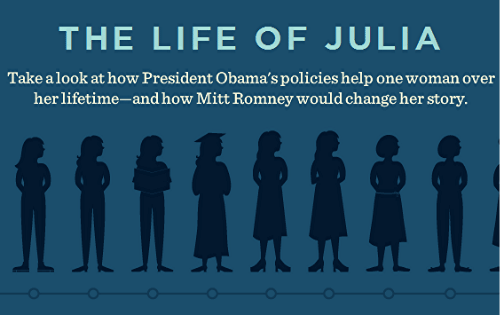
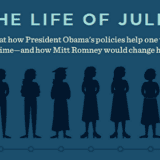
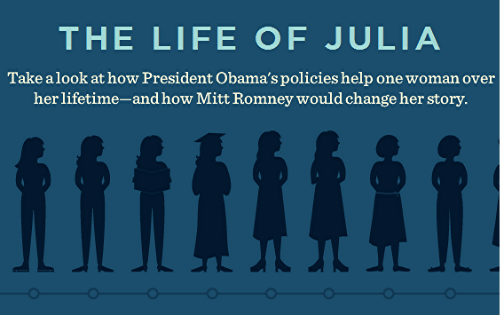
The president’s re-election campaign recently unveiled an Internet slideshow demonstrating to women some possible consequences of their votes this fall. The Life of Julia, a mini-biography in 11 episodes, has an imaginary toddler, Julia, enrolling in a Head Start program, a 27-year-old Web-designer Julia benefiting from mandated preventive health care coverage, and a retiree Julia living “comfortably” on Social Security. And it contrasts the fate of these programs under Obama and Romney policies. Visually engaging but hardly dramatic, well-pitched but far from edgy as campaign advertising, The Life of Julia, I am tempted to say, is not all that interesting in itself.
Not so the conservative response to Julia. Paul Ryan, the House Budget Committee chairman, pronounced the slideshow “creepy” and “demeaning.” Julia’s life is “banal and hackneyed,” wrote William Bennett, in a more literary frame of mind. Ross Douthat perceived liberal “condescension” at every turn of Julia’s fictional life.



We all want safe roads and bridges—free of debris, potholes and cracks. How do we intend to pay for this? (Insert the sound of crickets here.)
Our roads and bridges don’t actually pay for themselves. Currently, the state and the federal government collect $.357 (set to increase to $.360 on July 1) and $.182, respectively, from every gallon of gas we purchase to pay for road maintenance, modernization and new facilities. However, the pot of money that goes towards building and maintaining our roads and bridges has gotten smaller and smaller over the last three decades for several reasons:
1. Cars have become more fuel efficient
The U.S. Environmental Protection Agency (EPA) has continued to set higher standards for auto manufacturers to improve the fuel efficiency of cars. Over the last decade, in part due to CAFE (Corporate Average Fuel Economy) standards, auto manufacturers have unveiled more attractive hybrid and alternative-fuel vehicles,
» Read more about: The Elephant in the Room — Raising the Gas Tax »


 Today 1,000 new millionaires (and a few billionaires) are walking the planet, thanks to Facebook’s new IPO. Facebook has fundamentally changed the way people connect to each other and presents an unprecedented opportunity for advertisers to reach highly targeted markets. That explains its over-the-top, $104 billion valuation. What is not being talked about in the business sections is the technology that made Facebook possible. If you go to the “developer’s section” at the bottom of a Facebook page you will find this statement under “Open Source:”
Today 1,000 new millionaires (and a few billionaires) are walking the planet, thanks to Facebook’s new IPO. Facebook has fundamentally changed the way people connect to each other and presents an unprecedented opportunity for advertisers to reach highly targeted markets. That explains its over-the-top, $104 billion valuation. What is not being talked about in the business sections is the technology that made Facebook possible. If you go to the “developer’s section” at the bottom of a Facebook page you will find this statement under “Open Source:”
“Facebook has been developed from the ground up using open source software. Developers building with Platform scale their own applications using many of the same infrastructure technologies that power Facebook.”
“Developed from the ground up” — i.e., by the open-source communities that allow people to freely use, distribute and modify source code in unending cycles of improvement. If Ben Mezrich’s Facebook history,
» Read more about: How Mark Zuckerberg Became a Billionaire »


A few weeks back I stood at the corner of 65th and Normandie, in South Los Angeles, remembering what used to be there. An old church, maybe from the 1930s — Spanish Revival with white-washed plaster and enough curved red tile on the roof to make you think it might be real. The congregation members had long since moved away or died, and now the building itself was gone, replaced by sparkling new apartments with units exclusively designed for emancipated youth. Each year in Los Angeles County 1,500 kids get cut loose from the foster-parent system. They are 18 years old with no family, no job, no place to live, no skills and no support to learn any, which is why a majority will end up on the streets or in jail.
And this is why this building, the Epworth Apartments, means so much. Over the years, it could save the lives of scores of young adults.
» Read more about: South LA Story: A Garden and a Place Called Home »


By Carl Franzen
(Note: Last January Donald Cohen wrote here of the conservative political animus against new, green lighting technologies – namely, compact fluorescent light bulbs (CFLs). The following repost of a May 12 Talking Points Memo feature looks at the evolution of another alternative to wasteful incandescent lighting – illumination by light-emitting diodes (LEDs).
Battle lines were drawn in Las Vegas, Nevada this week at the 23rd annual Lightfair International trade show, an exposition of the latest in artificial lighting technology.
Spurred in part by the controversial, misunderstood, national phase-out of energy inefficient incandescent bulbs that began in January, companies are racing to develop light-emitting diode (LED) bulbs that meet the new energy standards, and yet will provide the same lighting quality that consumers are used to getting from the old, inefficient incandescents.



Until recently the Internet, along with the devices that brought it to us and the platforms that have expanded its usefulness, held a certain cool, selfless allure. The Web was mostly the idea of young, rule-breaking rebels, and their insurgent mystique made them hero geeks. Browsing a favorite blog on our laptops, a cup of red-eye coffee nearby, we felt a part of the New. Then money began doing what it always does to young, rule-breaking rebels – it turned them into our parents, our landlords and our loan officers.
It began in earnest, I suppose, with last year’s tiff between Amazon.com and the state of California over Sacramento’s insistence that the online retail behemoth start collecting state taxes on its sales. Amazon eventually struck “compromises” with California and other states that mostly favored Amazon. Many of us in California smiled – we got an extra year of purchasing on the site without paying taxes.
» Read more about: How Our Internet Heroes Lost Their Cool »


New York City’s Public Advocate, Bill de Blasio, and the Coalition for Accountability in Political Spending (CAPS) have put together a nifty online chart called 6 Degrees of Walmart. It’s actually more than a chart – think of it as a kind of star finder that allows the user to locate eight constellations of alleged corporate malfeasance and consumer abuse committed by the retail giant. Click on its Gun icon and you’ll find out how Walmart, through its support of the American Legislative Exchange Council (ALEC), backs Stand Your Ground laws. Click the Dollar sign and you’ll learn how Walmart colludes with the Business Roundtable and others to protect corporate tax subsidies.
(Please note: The above image is not interactive; to interact, go to the 6 Degrees of Walmart site.)
There’s also an explanation of how Walmart tries to burnish its environmental and corporate responsibility cred through its “sustainability program”


[caption id="attachment_8972" align="aligncenter" width="432"] Cassidy Noblett[/caption]
Cassidy Noblett[/caption]



(The following action alert comes from ClimatePlan.org; news of the alert first appeared at Housing California, which lists 18 Los Angeles County projects that could be affected by the transfer of housing construction funds.)
Senate President pro Tem Darrell Steinberg is considering using unencumbered housing funds from former redevelopment agencies to balance the 2012-13 state budget. Such a sweep would impact at least 175 pipeline developments poised to create 23,455 construction-phase jobs in the next two years.
In recent comments to the Sacramento Bee, Steinberg raised the possibility of abandoning his SB 654, which would preserve the low-mod balances for their original intended use. A survey indicates this move would threaten construction of at least 10,215 homes that were counting on the availability of redevelopment funding to move forward.
Key Assembly members recognize the value of the jobs and taxes generated by home construction,
» Read more about: State Housing Construction Funds in Jeopardy »
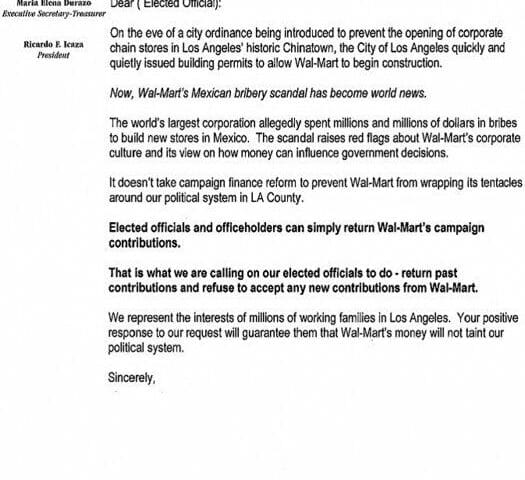


This week the Los Angeles County Federation of Labor sent letters to every elected official in L.A. County (including Congress members), urging them to return all campaign contributions they may have received from Walmart – and to refuse future donations from the retail giant. The letter, which is signed by a broad spectrum of union leaders, juxtaposes Walmart’s alleged bribery scheme in Mexico with L.A. City Hall’s quick approval of the corporation’s permits for a new store in Chinatown. (The letter’s text appears below.)
“It doesn’t take campaign finance reform,” the signatories say, “to prevent Walmart from wrapping its tentacles around our political system in L.A. County.”
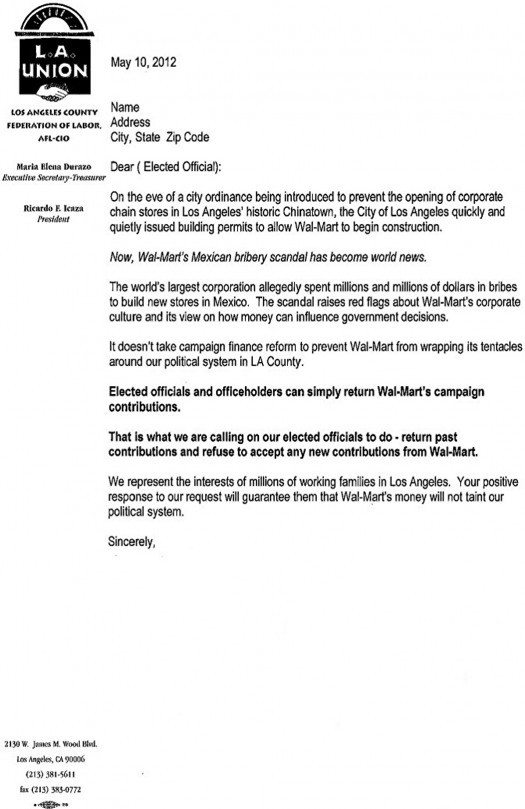
» Read more about: Labor to Electeds: Return Walmart Money! »


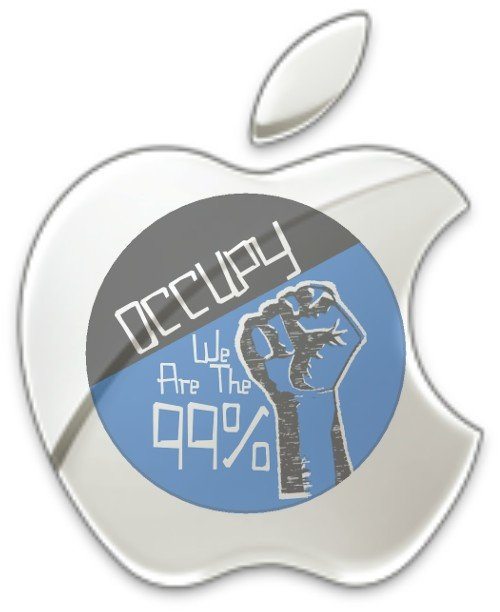 (The following post first appeared May 1 on Truthdig.)
(The following post first appeared May 1 on Truthdig.)
By Bill Boyarsky
By chance, the revelation of how Apple evades millions of dollars in taxes broke three days before May Day, when workers of the world traditionally protest such injustice.
Although the Apple practices aren’t illegal, the dodging of taxes on revenue generated, to a large extent, by low-wage Chinese workers, was a perfect introduction to this year’s May 1 observance, highlighted by the Occupy movement’s call for strikes and demonstrations around the country. The goal: Protest corporate domination of an economy being pulled downward by growing income inequality and intractable unemployment.
The New York Times reported that the technology company has used loopholes to reduce its tax bills in 21 states and overseas by billions of dollars annually by creating subsidiaries in places with low-tax or no-tax policies.
» Read more about: Organizing for Change: Different Drummers, Common Cause »


The SEC is dragging its feet implementing a section of the Dodd-Frank reform that would require publicly traded companies to calculate the ratio between the CEO’s pay and that of the firm’s median pay package. The New York Times editorial board urges them to push forward.
Corporate lobbyists say it’s too complicated to figure out the math. They figured out how to create uber-complex financial products that untangled the global economy, but aren’t able to divide the CEO’s earnings (they must know) by the median employee pay?
Of course, the real reason they oppose the law is that they don’t want to add fire to the public debate about excessive CEO salaries – certainly while the rest of America struggles to pay bills, put kids through college and afford mortgage payments. Obscurity, not transparency, benefits the privileged.
Their opposition to useful information for investors and consumers is a replay of earlier legislative battles.
» Read more about: Why Can’t CEOs Do the Math on Their Pay? »
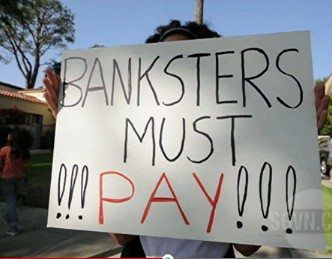
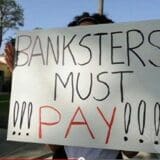
“About 100 Occupy protesters,” reports the Pasadena Star News, “seeking to reverse an eviction gathered Tuesday outside the Pasadena house of a Bank of America executive in the San Rafael neighborhood.” The newspaper said the home belonged to Raul Anaya, a B of A executive. The following LA Progressive post, by Occupy Fights Foreclosures member Cheryl Aichele, was written just prior to the action, which was designed to bring attention to the dire predicament of Dirma Rodriguez and other foreclosed homeowners.
By Cheryl Aichele
On Friday, David Redy — a partner at Redy & Smith— called Dirma Rodriguez, a widowed mother with a severely disabled daughter and four sons, who says she was fraudulently foreclosed upon by Bank of America. Allegedly during the conversation, Redy — who represents the bank— threatened Carlos Marroquin,
» Read more about: Bank of America Foreclosure Backlash in Pasadena »


 I am just a girl who can’t say “no.” In my youth this was actually a fun quality, but now it means that I spend a lot of time manning concession booths, volunteering in Sunday school classrooms, and doing whatever else the local Uber Mom has tasked me with. But make no mistake, I am not the Uber Mom. The Uber Mom is the mom who is always in charge. She knows everyone, runs every volunteer effort, and cooks absolutely everything from scratch.
I am just a girl who can’t say “no.” In my youth this was actually a fun quality, but now it means that I spend a lot of time manning concession booths, volunteering in Sunday school classrooms, and doing whatever else the local Uber Mom has tasked me with. But make no mistake, I am not the Uber Mom. The Uber Mom is the mom who is always in charge. She knows everyone, runs every volunteer effort, and cooks absolutely everything from scratch.
One thing I have noticed about these moms, whose astounding accomplishments are both impressive and deeply annoying (homemade marshmallows? really?), is that they are not dispersed evenly through society. This became particularly apparent to me when my own children moved from a private and rather expensive pre-school to a public school in LAUSD. Overnight we went (as my husband likes to point out) from being young,


 (The following announcement has previously appeared on other Web sites, including LA Progressive.)
(The following announcement has previously appeared on other Web sites, including LA Progressive.)
Practically everyone has an opinion about Obama’s health care, but few understand it, according to the latest Associated Press poll. The future of the president’s Affordable Care Act lies in the hands of the Supreme Court, which is expected to make a decision on the Act’s constitutionality in June. Meanwhile 40 million people are without health insurance.
A free public conference – Health Care: Where Are We Now? — will address the health-care debate:
Saturday, May 12, from 9 a.m.-12:30 p.m.
at Pasadena City College, Harbeson Hall
1570 E. Colorado Blvd., Pasadena
A coalition of community based organizations in Southern California led by the League of Women Voters Pasadena and Health Care for All – San Gabriel Valley is sponsoring the conference.
Other organizations include Physicians for a National Health Program,
» Read more about: Health Care Debate: A Free Public Conference »



There they go again. The Heartland Institute, which The New York Times rather generously describes as a “libertarian organization,” recently felt compelled to yank a line of billboards comparing believers in climate change to mass murderers and dictators. “I Still Believe in Global Warming. Do You?” asked one billboard featuring a picture of Unabomber Ted Kaczynski. More boards had been planned for Chicago, in a run-up to the institute’s Seventh International Conference on Climate Change, a kind of Coachella for climate-change deniers. Those ads showed photos of Charles Manson, Fidel Castro and Osama bin Laden.
Apparently even some of Heartland’s fellow climate-change deniers began feeling a little queasy over the campaign and so the Windy City-based group killed its plan. Not with any remorse, however. Institute president Joseph Bast released this statement:
“We know that our billboard angered and disappointed many of Heartland’s friends and supporters .
» Read more about: Climate-Change Denier Group Is Feeling the Heat »



By Rebecca Band
(This post first appeared May 7 on the Labor’s Edge blog site.)
One BILLION Dollars. That’s how much California gives away every year to big corporations, thanks to a wasteful tax loophole that actually incentivizes companies to close up shop in California and move those jobs elsewhere.
According to L.A. Times columnist George Skelton:
You might think a tax law that rewards companies for killing California jobs and resurrecting them in another state would be dumped. Very quickly. Especially if it also rewards them for selling off property here and rebuilding elsewhere. Or, put another way, if the law provides a tax incentive not to hire or invest in California in the first place. You’d repeal it. A no-brainer.
Makes no sense, except for the companies using the loophole while profiting from selling their products here in the nation’s largest consumer market.
» Read more about: State's Corporate Tax Breaks: Loopholes or Black Holes? »


First the Beverly Hills Unified School District ended its tradition of allowing B.H.-adjacent kids to attend that posh city’s schools. Now the local PTA is fighting tooth and French nail to keep subway trains from traveling under Beverly Hills High School via the proposed Westside Subway Extension. The subway has been planned to run through a nine-mile tunnel connecting the current Wilshire and Western terminus of the Purple Line to downtown Santa Monica.
The PTA, according to a Los Angeles Times piece, has released a scare video that predicts “a doomsday scenario” in which students could be incinerated in the event a train somehow ignites a plume of subterranean methane gas left over from the oil wells the school was built on. But if the school is sitting on such a potential box of dynamite, why isn’t it shut down immediately – with or without a subway?
» Read more about: WebHot: Beverly Hills Says, “Not Under My Back Yard!” »


(Editor’s Note: This post first appeared May 3 on Huffington Post.)
Today is Pete Seeger’s 93rd birthday.
What’s an appropriate gift for the most influential folk artist of the 20th century? A few years ago some of Pete’s fans launched a campaign to nominate him for the Nobel Peace Prize. It is time to resurrect that effort.
No one can get a crowd singing like he can. The songs he has written, including the antiwar tunes “Where Have All the Flowers Gone?,” “If I Had a Hammer,” and “Turn, Turn, Turn” (whose text is drawn from Ecclesiastes), and those he has popularized, including “This Land Is Your Land,” “Guantanamera,” “Wimoweh,” and “We Shall Overcome,” have been recorded by hundreds of artists in many languages and have become global anthems for people fighting for freedom. His songs are sung by people in cities and villages around the world,